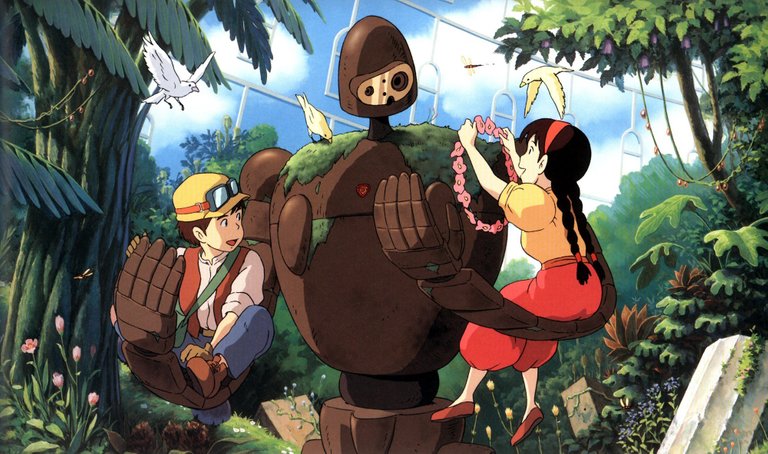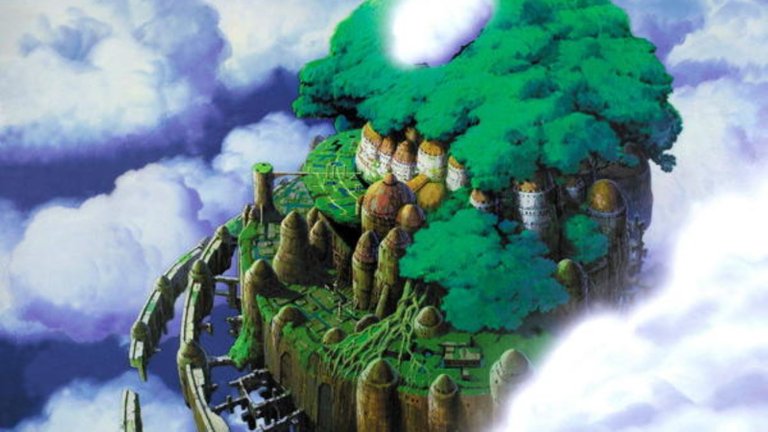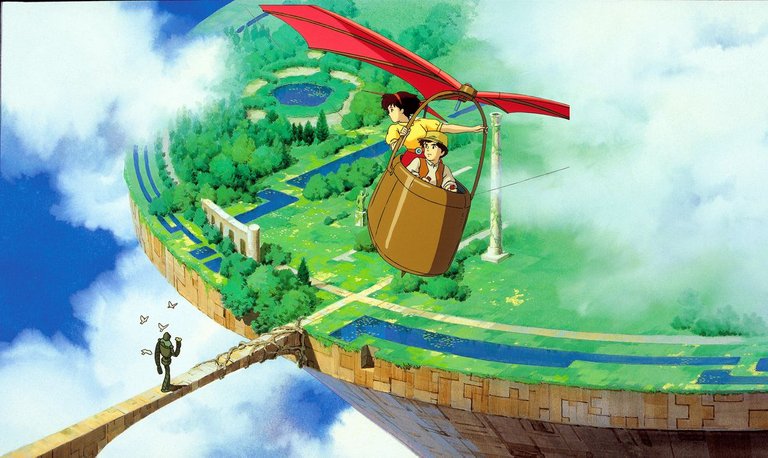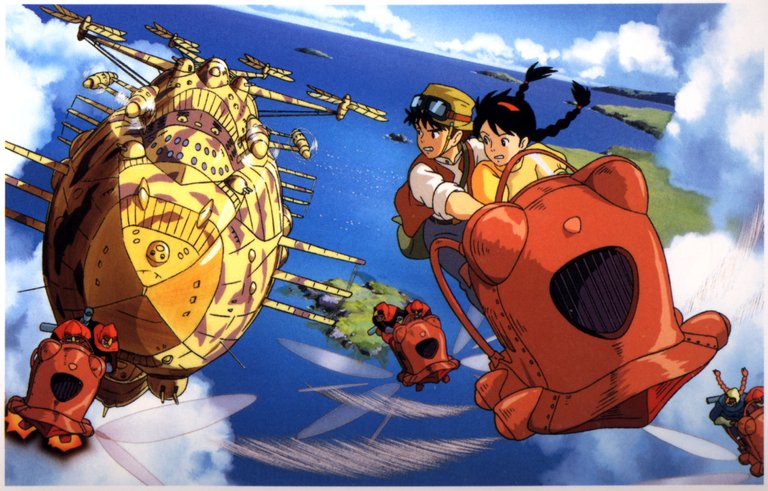A review of "Laputa: Castle in the Sky" - the difficult relationship between nature, mankind and robots

Source
Plot
A group of air pirates lead by the aged but tenacious Dola, the "mother" of the entire crew, attack an airship carrying Sheeta, a young girl wearing a weird stone around her neck, trying to kidnap her. The stone Sheeta wears around her neck—desired by both kidnappers and air pirates—"activates" by lighting up and allows an unconscious Sheeta to lie on the ground unharmed, all in front of her peer Pazu, who watches in astonishment. Sheeta falls from the aircraft during the ensuing battle and appears destined to crash to the ground. Pazu tells her about his discovery of his deceased father: one day while he was flying, escaping a storm, he sees in the distance, beyond the blanket of clouds, the legendary island of Laputa. Sheeta wakes up at the orphan's house the following morning after the fanfare with which the boy regularly seems to greet the new day. Pazu decides to assist Sheeta in getting to the island in order to restore the reputation of his father, who was never credited for this discovery.
A race against time to get to the island before Muska, Sheeta's "jailer," and his soldiers do so, begins for the two youngsters;

Source
Why you should watch it?
Unjustly, Tenkū no Shiro Rapyuta, also known as Laputa: Castle in the Sky, is among the least well-known of Master Hayao Miyazaki's creations. And this is despite the fact that a remarkable collection of factors confirm the significance of this great classic.
Firstly, it is the first true film produced by Studio Ghibli (which was established largely as a result of the financial success of the previous Nausicaä of the Valley of the Wind). Additionally, it serves as a kind of manifesto for the studio's themes, which were already hinted at in its earlier work, as well as its aesthetic and method of operation.
Miyazaki bases his story, or project, on the concept of the flying island from the third book of Gulliver's Travels while borrowing elements from Nausicaä and Conan, Boy of the Future (along with a brief cameo from a creature created for a Lupin III° episode). This story, or project, is representative of the creation of Japanese animated drawings common to the 1980s.

Source
In Laputa - Castle in the Sky, Miyazaki explores some of his favorite subjects:
- the interaction between man and nature
- the application of science and technology
- war.
Our two main characters will have to face a lot of adversities during their adventure, but this won't stop them from pursuing their goals; Sheeta wants peace, while Pazu wants justice for his father. He has created his own plane just for this reason in order to get to the celestial island. Laputa will be saved by both of their pure hearts. But Colonel Muska's situation is different since he is more motivated than anyone to claim the stolen treasure. Laputa: Castle in the Sky is a fantastic anti-militarist tale, to put it briefly.

Source
But it's also crucial to recognize how significantly this movie departs from the director's earlier works: in this movie, there are real villains, whereas in the master's other works, the antagonists' representations of human wickedness are always elusive, as if to somehow shield even the antagonists from the wickedness that inherently surrounds man. The fact that the feature film may both be a landmark in the director's filmography yet adversely deviate from established canons makes it special and notable. Human malice increases as we draw closer to the potential of developing weapons of mass devastation; the echo of the atomic bombs in Japan is still too strong to ignore. In this movie, men actually die, a rare feature in the filmography of the Master. The primary adversary, a government representative, is thus completely obedient to his mission and has no regard for his coworkers or the rest of the populace. Once in Laputa, his objective is to rule and eliminate everyone who disobeys his authority. The pessimism toward human wickedness reaches its height when the beautiful and untainted landscape of Laputa, controlled by cutting-edge technology up to that point only concerned itself with the well being of the island, is disturbed by those very robots that, if controlled and operated by humans, no longer bring well being but destruction and misery.
However, the director shows us that there is still a way out and redemption for humanity, not only through the two young protagonists but also through the iconic sky pirates, who the viewer initially views as villains but who are revealed to be upholders of extremely high values that no one can understand during the screening. But Pazu's neighbors can also save humanity from an all too cruel observation; they protect the girl from her kidnappers without expecting anything in return because of the hardships they have endured their entire lives.

Source
Conclusion
The Castle in the Sky is one of the most daring and exciting works by the Japanese master, balancing action and mystery, sentiment and philosophy, science and magic without ever sacrificing poetry or wonder. Although it is undeniably not as technically advanced as the later movies, the careful attention to detail and Joe Hisaishi's magnificent music (as always 😊) mesmerize without fail.
Rating
My personal vote is:
8.5/10

Your content has been voted as a part of Encouragement program. Keep up the good work!
Use Ecency daily to boost your growth on platform!
Support Ecency
Vote for new Proposal
Delegate HP and earn more
Hello! I'm happy to see so many Ghibli reviews, I think they're never recognized enough, especially this one.
Castle in the Sky has been one of the Studio Ghibli movies that has excited me the most when I saw it, the way the two kids try to escape the villains it's really amazing and kept me expectant throughout the movie. As you say, this film seems to be influenced by war, But when I saw it, I remember that, it left me with the idea of an ecological message, because it also shows us that it is important to protect "pure" places like Laputa and that, in the end, is the most important thing.
One of the things I liked most about castle in the sky was its aesthetic and Steampunk theme, I think it gave an incredible touch to the story. In this point, for me, the pirates stood out with their aircrafts and weapons. As you say, at first they are presented to us as not so good people, but in the end they end up being the opposite, that for me was something prevailing because it shows that anyone can do good if they choose to, so, I totally agree with you that this is one of the greatest teachings of this film:
Thank you very much for sharing this amazing movie and, as usual, kudos for this wonderful review. ✌️❤️🤗
I love happy faces this one has already gotten my attention, a castle floating on air is a great place to dwell but don't fall, lol.
Interesting one, you just did a great review.
It is always good when they mix science in these animes!
!1UP
Click this banner to join "The Cartel" discord server to know more.
You have received a 1UP from @gwajnberg!
@cine-curator, @neoxag-curator
And they will bring !PIZZA 🍕.
Learn more about our delegation service to earn daily rewards. Join the Cartel on Discord.
OHHH I love "Castle in the Sky" 😁🙌
🥦 !BBH !PGM 🥦
Thanks man 😊
😉👏👏 Have a good day~~~
Because this is such an awesome post, here is a BBH Tip for you. . Keep up the fantastic work
. Keep up the fantastic work